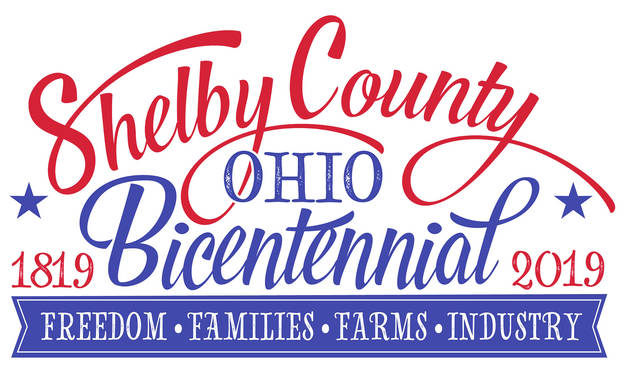
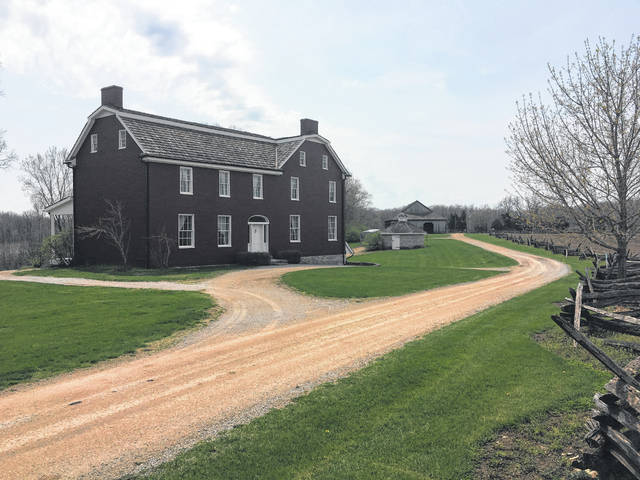
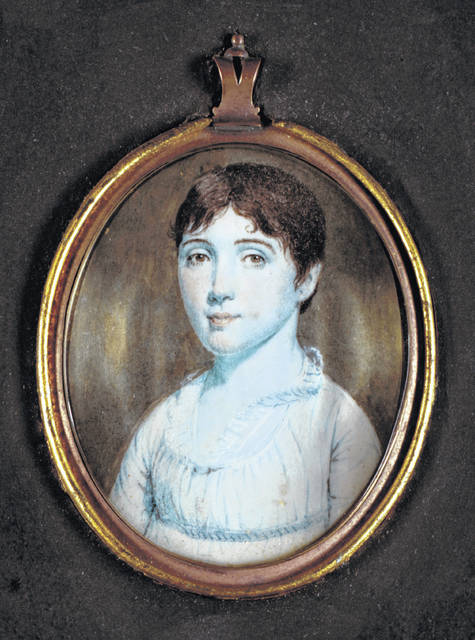
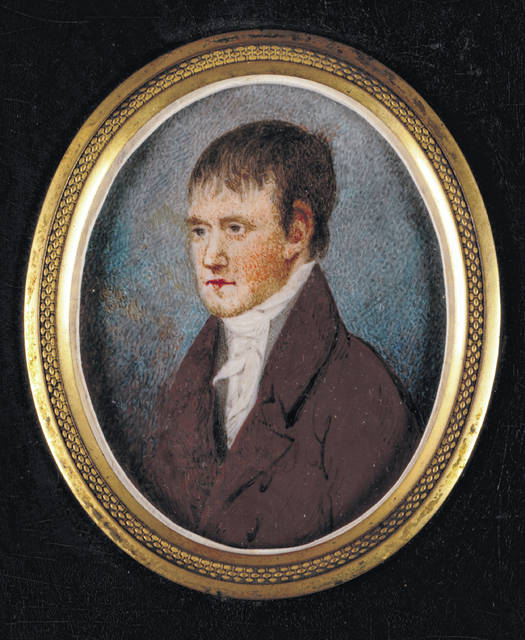
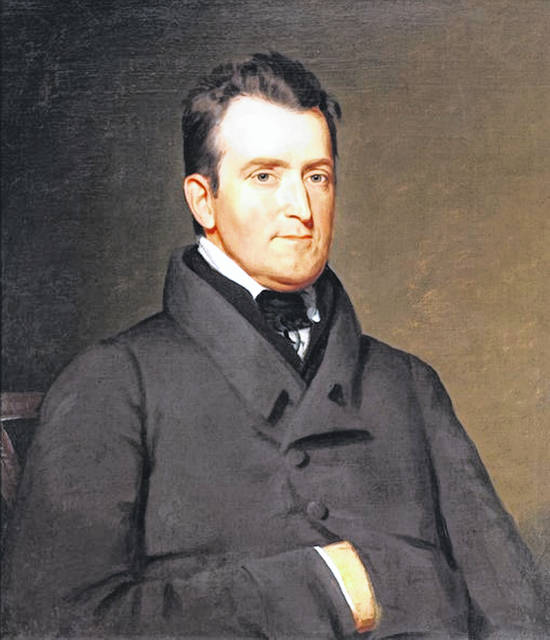
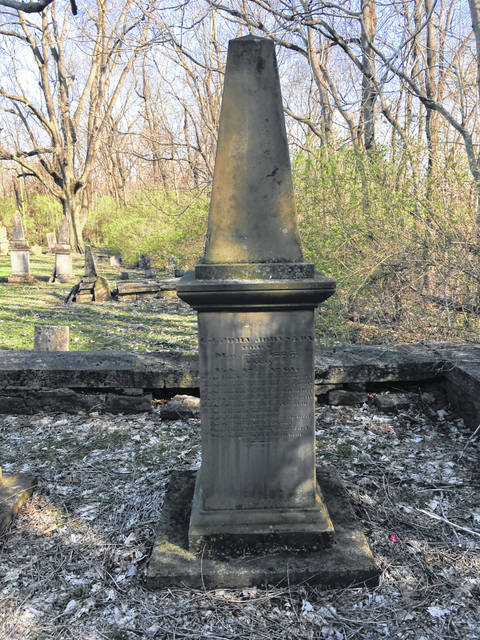
Editor’s note: in conjunction with the 200th celebration of the establishment of Shelby County, the Sidney Daily News will be publishing a year long series about the county’s history.
Author’s note: My research has convinced me that Colonel Johnston’s fair treatment of the Native American tribes entrusted to his care kept them from entering the War of 1812 on the side of the British. That tipped the outcome of the war in favor of the young American nation. Without the key role Colonel Johnston played, America would be a far different county today.
John Johnston experienced love at first sight twice in his life. The first occasion was when he traveled through the upper Miami Valley. The second was when he met Rachel Hoping Robinson.
Both loves were transformative, changing not only his life but the lives of countless thousands of others continuing to this very day. Born March 25, 1775, young John Johnston immigrated to America from Ireland. Just 11 years of age, he was entrusted to the care of an Anglican priest, who traveled with him and also served as his tutor.
His father, mother, four brothers and one sister remained in Ireland. They immigrated to America five years later. By that time, John Johnston had made his way to Pennsylvania. His family followed in his footsteps, settling there as well.
John Johnston first traveled to Ohio as a member of General “Mad” Anthony Wayne’s Legion of the United States. A wagoner, John Johnston was still in his teens when he first saw and fell in love with the verdant land along the Great Miami River that was eventually to become his family’s home.
Following the signing of the Treaty of Greenville, John Johnston returned to Pennsylvania. He spent several years working as a law clerk. When he was 27, John Johnston met Rachel Hoping Robinson, and fell in love for the second time in his life.
Just 16, Rachel’s parents did not look favorably upon the couple’s romance. Staunch Quakers, their opposition was based on their religious differences with John Johnston’s Episcopal faith, the difference in their ages, and the fact that John Johnston’s work would take their daughter hundreds of miles away.
Although their love for each other was frustrated by her parent’s strong opposition, the two did not let the Robinson’s objections deter them. They eloped to Lancaster, Pennsylvania, and were married on July 15, 1802.
They continued their trek westward to Fort Wayne, Indiana. President Thomas Jefferson had appointed John Johnston as Indian factor for the newly established trading agency in Fort Wayne. His primary responsibility was to manage trade with the Indians so that they had all the goods they needed and would not seek to trade with the British.
John Johnston was directly responsible to Indiana’s territorial governor, William Henry Harrison, and to John Shee, superintendent of Indian Trade. Under official government policy, trade with the Indians was not intended to be a profit-making enterprise. Rather, it was hoped that by selling goods to the Indians at cost, plus expenses, the government would be able to establish more harmonious relations with the various tribes.
The first years of John and Rachel’s married life were not easy. They were far removed from the comforts of Pennsylvania. The first five of their 15 children were born at Fort Wayne. They were, in fact, the first Caucasian children born in that part of the wilderness. The first of their children, Stephen, was born April 2, 1803. Rebecca was born Sept. 3, 1805, unfortunately dying April 26, 1808. Elizabeth was born Sept. 22, 1807, followed by Rosanna (July 2, 1809) and Juliana (Aug. 11, 1811.)
John and Rachael Johnston remained at Fort Wayne through a period of growing resentment between the Indians and the United States, fueled in part by conflict between John Johnston, the trusted agent of the government, and William Wells, the official Indian agent at Fort Wayne. The Miami Indians had adopted Wells into their tribe. Well’s loyalty to the United States was doubted by government officials. Their trust was placed in John Johnston, who had established a reputation for fair dealings with all parties.
John Johnston filed a report summarizing Indian accounts of the Battle of Tippecanoe (Nov. 7, 1811.) Shortly thereafter, the government established a new agency at Piqua, Ohio, and John Johnston requested to be transferred to that new agency. He moved his young family to Piqua, establishing his factory (the term used for the Indian agencies at the time) on the land where he was to build the home.
John Johnston, in his own words, described the area in a letter he wrote in 1838.
“The first time I saw the spot upon which I now live, the determination was formed if ever the land could be purchased I would at any price commensurate with my means become the owner of a tract of about 250 acres of elevated, rich dry prairie, covered with grass. Skirted with the most beautiful woods, an unusually large and never failing spring of the purest and coldest water springing out of the second bank of the Great Miami River, immediately in the rear of which a delightful building spot, 40 feet above the river, half a mile below the mouth of the Loramie Creek.”
During the War of 1812, John Johnston was appointed colonel and served as quartermaster and paymaster for General Harrison’s Army. At one point, he sent his family to Dayton fearing for their safety. Fortunately, calm prevailed, and his family soon returned.
The Johnston’s life, in what Col. Johnston always referred to as Upper Piqua, was filled with activity. Rachel and John had 10 more children. Mary was born Nov. 28, 1813. Her birth was followed by that of Abraham (May 23, 1815) Rachel (Nov. 24, 1816) Rebecca (April 2, 1818) John (June 25, 1820) Catherine (March 8, 1822) William Bernard (Jan. 22, 1824) Margaret (Sept. 10, 1825) Harriet (Aug.16, 1827) and, James (May 5, 1830).
In addition to being an Indian agent who had a reputation for dealing fairly with the Native Americans entrusted to his care, John Johnston was a husband, father and progressive farmer. He was also a canal commissioner, a published author (Indian Tribes in Ohio), a founder of Kenyon College, a trustee of Miami University and a member of the Board of Visitors at West Point.
Although encumbered with the many duties that were part of managing a pioneer rural home, Rachel was also a leader. Her interest in religion and education paralleled those of her husband. Together they dedicated a plot of ground for the construction of the area’s first Methodist Episcopal Church. By 1824, the Methodists had relocated to downtown Piqua, and had no future need for the building. They deeded the property back to the Johnstons.
The following year, the improved property was deeded to the trustees of St. James Episcopal Church. Rachel formed the first Women’s Auxiliary at St. James. Perhaps more importantly, she founded the first Sunday School to be formed in Miami County.
In 1818, John Johnston helped to organize the Episcopal Diocese of Ohio. That same year, Rachel mounted her horse and on horseback, personally invited the women of the community to consider forming the Women’s Bible Society. That society was formed April 18, 1818, and Rachel served as the society’s second president, a position she held for 11 years.
Throughout his years as an Indian agent, John Johnston enjoyed a good relationship with the Native Americans. Both the Shawnee and Wyandot entrusted to his care respected him greatly. He served as an Indian agent until 1829, when he was fired by President Andrew Jackson, who introduced the Spoils System (the president appoints civil servants to government jobs specifically because they are loyal to him and to his political party) to the American political scene.
Even so, John Johnston’s mutual respect for the Native Americans continued. He helped negotiate the Treaty of Upper Sandusky in 1842, which removed the Wyandot from Ohio to the West.
“They continued to resort to me for counsel and advice, notwithstanding I had been removed without cause I continued to give them the best advice of which I was capable. Their visits which were frequent were a very serious loss to me, eating up my provisions and horse feed, yet up to the time of their final removal to Missouri my house was always open to them and when the chiefs and myself parted forever it was not without the shedding of many tears,” Johnston wrote some years later.
John and Rachel Johnston were married for 38 years before Rachel became ill and 11 days later, died (July 24, 1840). John Johnston was devastated. His bereavement after the death of his wife caused him to leave the home he loved. He purchased a home in Cincinnati and moved there with his daughter, Margaret. He lived there until her death of cholera in June 1849.
He subsequently sold the Cincinnati property and moved to Dayton, residing there with his daughter, Julia (Mrs. Jefferson Patterson). He visited Upper Piqua in May 1855. Just prior to departing, he wrote: “I have spent two weeks this day at a place once so dear to me, and now made so desolate by the hand of death. Much of my time has been spent in the cemetery among the monuments of my dear mother, brothers, wife and children. I go back to Dayton this day and may never return here again until some surviving friend may bring my remains here to be deposited by the side of my beloved wife, Rachel.”
John Johnston traveled to Washington, D.C., in 1861 to petition the government for reimbursement for the supplies he had furnished the Indians and expenses incurred in negotiating the Treaty of Upper Sandusky. He died there Feb. 18, 1861.
John Johnston’s body was returned to Piqua. He was buried on Feb. 22, 1861, next to his beloved Rachel. There, John Johnston was reunited in death with his two loves.







